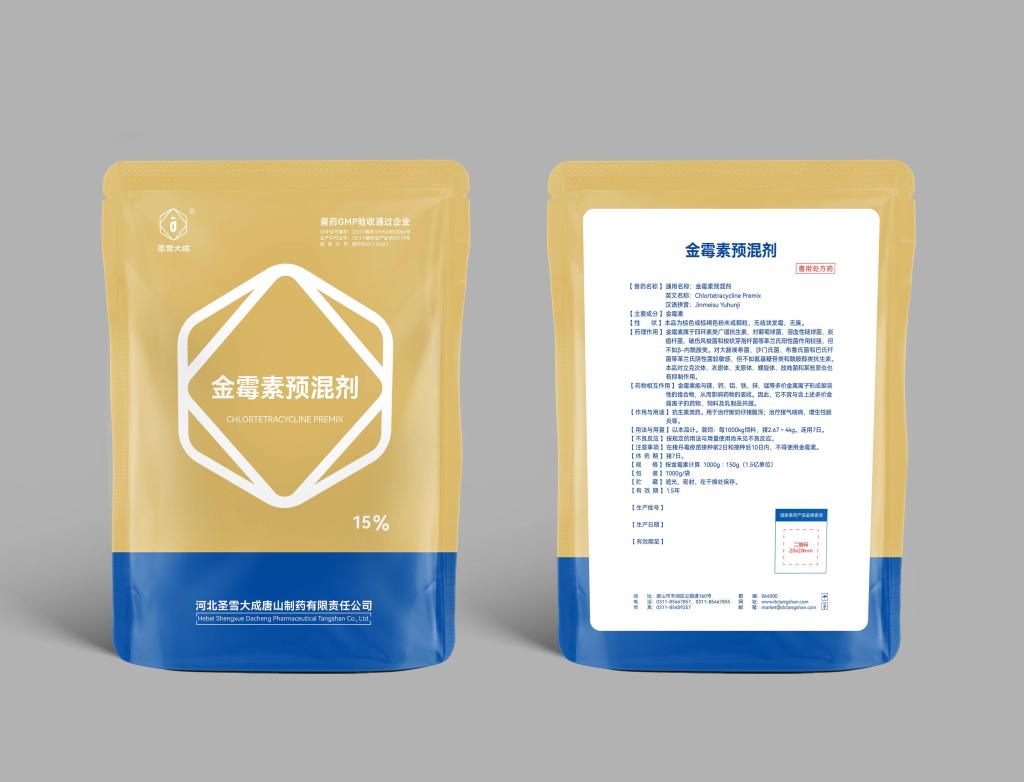Tel:+8618231198596

News
 CONTACT
CONTACT
 CONTACT
CONTACT
- Linkman:Linda Yao
- Tel: +8618231198596
- Email:linda.yao@dcpharma.cn
- Linkman:CHARLES.WANG
- Department:Overseas
- Tel: 0086 0311-85537378 0086 0311-85539701
News
Exploring the global usage patterns of Chlortetracycline Premix in animal agriculture.
TIME:2024-06-03
Understanding Chlortetracycline Premix:
Chlortetracycline is a broad-spectrum antibiotic belonging to the tetracycline class of antimicrobial agents. It is effective against a wide range of Gram-positive and Gram-negative bacteria, as well as certain protozoa and rickettsiae. Chlortetracycline premix is formulated as a feed additive, typically in the form of a powder or granules, and is mixed with animal feed to deliver a predetermined dosage to livestock.
Applications in Animal Agriculture:
Disease Prevention: Chlortetracycline premix is commonly used for the prevention and control of bacterial diseases in livestock, including respiratory infections, enteric diseases, and reproductive disorders. It is particularly effective against bacterial pathogens such as Escherichia coli, Salmonella, Pasteurella, and Mycoplasma.
Feed Efficiency: Chlortetracycline premix has been shown to improve feed efficiency and promote growth in livestock, leading to increased weight gain and better overall performance. It acts by inhibiting bacterial protein synthesis and reducing the microbial population in the gastrointestinal tract, thereby improving nutrient absorption and utilization.
Coccidiosis Control: In poultry production, Chlortetracycline premix is used for the prevention and control of coccidiosis, a common parasitic disease caused by Eimeria species. It helps to reduce the severity of clinical signs, prevent secondary bacterial infections, and improve flock health and productivity.
Global Usage Patterns:
Geographical Distribution: Chlortetracycline premix is widely used in animal agriculture globally, with significant consumption in countries with intensive livestock production systems, including the United States, China, Brazil, India, and European countries. The usage patterns vary depending on factors such as livestock species, production practices, disease prevalence, and regulatory frameworks.
Livestock Species: Chlortetracycline premix is used in various livestock species, including poultry, swine, cattle, sheep, and aquaculture. Poultry and swine production are the largest consumers of Chlortetracycline premix globally, followed by cattle and aquaculture.
Production Practices: Chlortetracycline premix is commonly used in intensive livestock production systems, such as feedlots, confinement operations, and commercial poultry farms. It is often included in starter feeds, grower diets, and finisher rations to support animal growth and health throughout the production cycle.
Regulatory Landscape: The regulatory framework governing the use of Chlortetracycline premix varies between countries and regions. In some countries, Chlortetracycline premix is available over the counter and can be purchased without a prescription, while in others, it is classified as a prescription drug and requires veterinary oversight.
Regulatory Challenges:
Antimicrobial Resistance: One of the primary concerns associated with the use of Chlortetracycline premix in animal agriculture is the development of antimicrobial resistance (AMR). Overuse and misuse of antimicrobial agents, including Chlortetracycline, can contribute to the emergence of resistant bacterial strains, posing a threat to human and animal health.
Residue Management: Another challenge is the management of antibiotic residues in animal products, such as meat, milk, and eggs. The presence of Chlortetracycline residues in food of animal origin can pose risks to consumer health and may lead to regulatory non-compliance and trade restrictions.
Regulatory Harmonization: Achieving regulatory harmonization and standardization of Chlortetracycline use across countries and regions remains a significant challenge. Divergent regulatory approaches, including differences in maximum residue limits (MRLs), withdrawal periods, and labeling requirements, can complicate international trade and market access.
Alternative Strategies: There is a growing need for alternative strategies to reduce the reliance on antimicrobial agents like Chlortetracycline in animal agriculture. This includes the development and adoption of alternative feed additives, vaccines, probiotics, and management practices to prevent and control diseases without the use of antibiotics.
Future Prospects:
Antibiotic Stewardship: Enhancing antibiotic stewardship and promoting responsible antimicrobial use in animal agriculture are essential for mitigating the risks associated with Chlortetracycline and other antimicrobial agents. This includes implementing judicious use principles, promoting good husbandry practices, and adopting strategies to minimize AMR development.
Research and Innovation: Continued research and innovation are needed to develop alternative approaches for disease prevention and control in animal agriculture. This includes the development of novel antimicrobial agents, vaccines, feed additives, and management practices that are effective, sustainable, and environmentally friendly.
Regulatory Oversight: Strengthening regulatory oversight and surveillance of antimicrobial use and resistance in animal agriculture is critical for protecting animal and public health. This includes monitoring antibiotic sales and usage data, conducting surveillance for AMR in livestock and food products, and enforcing compliance with regulatory standards.
International Collaboration: International collaboration and cooperation are essential for addressing the global challenges posed by antimicrobial resistance in animal agriculture. This includes sharing best practices, harmonizing regulatory standards, and coordinating research efforts to develop sustainable solutions to combat AMR.
In conclusion, Chlortetracycline premix plays a significant role in animal agriculture globally, contributing to disease prevention, feed efficiency, and livestock productivity. However, its widespread use raises concerns about antimicrobial resistance, residue management, and regulatory harmonization. Addressing these challenges will require collaborative efforts from governments, industry stakeholders, researchers, and consumers to ensure the responsible use of Chlortetracycline and promote sustainable animal production practices.
- Tel:+8618231198596
- Whatsapp:18231198596
- Chat With Skype







